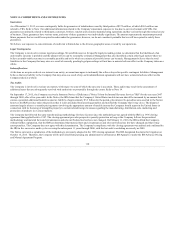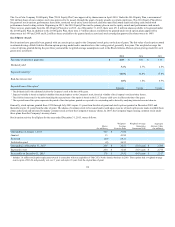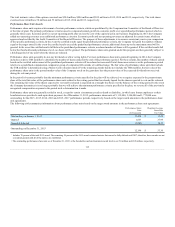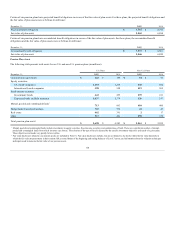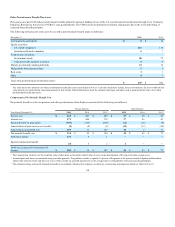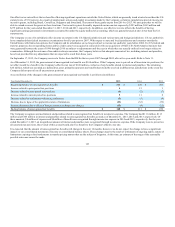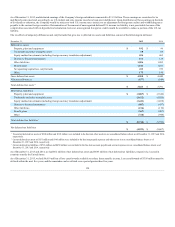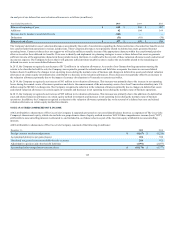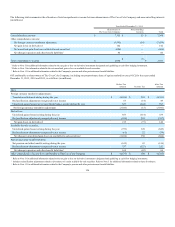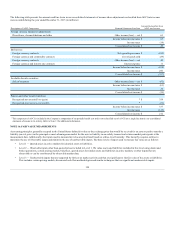Coca Cola 2015 Annual Report Download - page 122
Download and view the complete annual report
Please find page 122 of the 2015 Coca Cola annual report below. You can navigate through the pages in the report by either clicking on the pages listed below, or by using the keyword search tool below to find specific information within the annual report.
Certain weighted-average assumptions used in computing net periodic benefit cost are as follows:
Pension Benefits
Other Benefits
Year Ended December 31,
2014
2013
2014
2013
Discount rate
4.75%
4.00%
4.75%
4.00%
Rate of increase in compensation levels
3.50%
3.50%
N/A
N/A
Expected long-term rate of return on plan assets
8.25%
8.25%
4.75%
4.75%
The expected long-term rate of return assumption for U.S. pension plan assets is based upon the target asset allocation and is determined using forward-
looking assumptions in the context of historical returns and volatilities for each asset class, as well as correlations among asset classes. We evaluate the rate
of return assumption on an annual basis. The expected long-term rate of return assumption used in computing 2015 net periodic pension cost for the U.S.
plans was 8.5 percent. As of December 31, 2015, the 5-year, 10-year and 15-year annualized return on plan assets for the primary U.S. plan was 6.7 percent,
5.4 percent and 5.7 percent, respectively. The annualized return since inception was 10.6 percent.
The assumed health care cost trend rates are as follows:
December 31,
2014
Health care cost trend rate assumed for next year
7.50%
Rate to which the cost trend rate is assumed to decline (the ultimate trend rate)
5.00%
Year that the rate reaches the ultimate trend rate
2020
The Company's U.S. postretirement benefit plans are primarily defined dollar benefit plans that limit the effects of medical inflation because the plans have
established dollar limits for determining our contributions. As a result, the effect of a 1 percentage point change in the assumed health care cost trend rate
would not be significant to the Company.
The discount rate assumptions used to account for pension and other postretirement benefit plans reflect the rates at which the benefit obligations could be
effectively settled. Rates for U.S. and certain non-U.S. plans at December 31, 2015, were determined using a cash flow matching technique whereby the rates
of a yield curve, developed from high-quality debt securities, were applied to the benefit obligations to determine the appropriate discount rate. For other
non-U.S. plans, we base the discount rate on comparable indices within each of the countries. The rate of compensation increase assumption is determined by
the Company based upon annual reviews. We review external data and our own historical trends for health care costs to determine the health care cost trend
rate assumptions.
Effective January 1, 2016, for benefit plans using the yield curve approach, the Company changed the method used to calculate the service cost and interest
cost components of net periodic benefit costs for pension and other postretirement benefit plans and will measure these costs by applying the specific spot
rates along the yield curve to the plans' projected cash flows. The Company believes the new approach provides a more precise measurement of service and
interest costs by improving the correlation between projected cash flows and the corresponding spot yield curve rates. The change does not affect the
measurement of the Company's pension and other postretirement benefit obligations for those plans and is accounted for as a change in accounting estimate,
which is applied prospectively.
Cash Flows
Our estimated future benefit payments for funded and unfunded plans are as follows (in millions):
Year Ended December 31, 2016
2017
2018
2019
2020
2021–2025
Pension benefit payments $ 521
$ 504
$ 533
$ 551
$ 570
$ 3,065
Other benefit payments1
61
63
64
65
67
332
Total estimated benefit payments $ 582
$ 567
$ 597
$ 616
$ 637
$ 3,397
1 The expected benefit payments for our other postretirement benefit plans are net of estimated federal subsidies expected to be received under the Medicare Prescription Drug,
Improvement and Modernization Act of 2003. Federal subsidies are estimated to be $4 million for the period 2016–2020, and $3 million for the period 2021–2025.
The Company anticipates making pension contributions in 2016 of $512 million, the majority of which will be allocated to our U.S. plans. The majority of
these contributions are discretionary.
120


